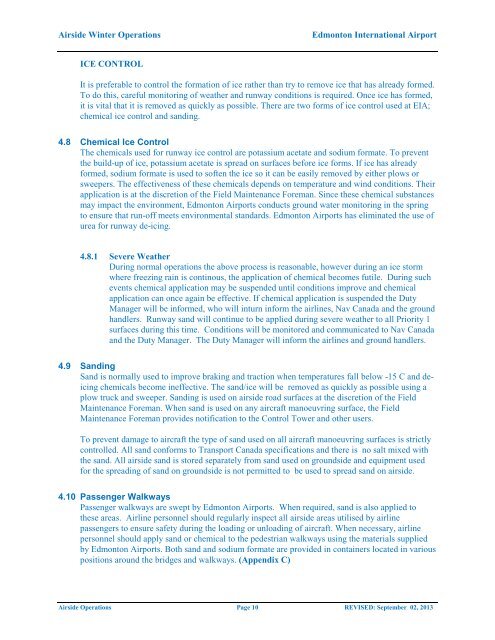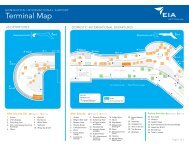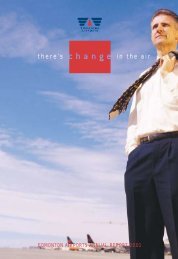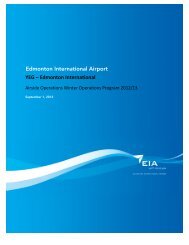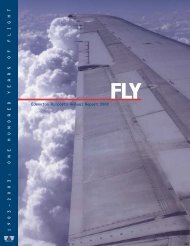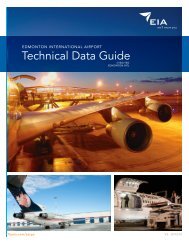YEG â Edmonton International Edmonton International Airport
YEG â Edmonton International Edmonton International Airport
YEG â Edmonton International Edmonton International Airport
You also want an ePaper? Increase the reach of your titles
YUMPU automatically turns print PDFs into web optimized ePapers that Google loves.
Airside Winter Operations<strong>Edmonton</strong> <strong>International</strong> <strong>Airport</strong>ICE CONTROLIt is preferable to control the formation of ice rather than try to remove ice that has already formed.To do this, careful monitoring of weather and runway conditions is required. Once ice has formed,it is vital that it is removed as quickly as possible. There are two forms of ice control used at EIA;chemical ice control and sanding.4.8 Chemical Ice ControlThe chemicals used for runway ice control are potassium acetate and sodium formate. To preventthe build-up of ice, potassium acetate is spread on surfaces before ice forms. If ice has alreadyformed, sodium formate is used to soften the ice so it can be easily removed by either plows orsweepers. The effectiveness of these chemicals depends on temperature and wind conditions. Theirapplication is at the discretion of the Field Maintenance Foreman. Since these chemical substancesmay impact the environment, <strong>Edmonton</strong> <strong>Airport</strong>s conducts ground water monitoring in the springto ensure that run-off meets environmental standards. <strong>Edmonton</strong> <strong>Airport</strong>s has eliminated the use ofurea for runway de-icing.4.8.1 Severe WeatherDuring normal operations the above process is reasonable, however during an ice stormwhere freezing rain is continous, the application of chemical becomes futile. During suchevents chemical application may be suspended until conditions improve and chemicalapplication can once again be effective. If chemical application is suspended the DutyManager will be informed, who will inturn inform the airlines, Nav Canada and the groundhandlers. Runway sand will continue to be applied during severe weather to all Priority 1surfaces during this time. Conditions will be monitored and communicated to Nav Canadaand the Duty Manager. The Duty Manager will inform the airlines and ground handlers.4.9 SandingSand is normally used to improve braking and traction when temperatures fall below -15 C and deicingchemicals become ineffective. The sand/ice will be removed as quickly as possible using aplow truck and sweeper. Sanding is used on airside road surfaces at the discretion of the FieldMaintenance Foreman. When sand is used on any aircraft manoeuvring surface, the FieldMaintenance Foreman provides notification to the Control Tower and other users.To prevent damage to aircraft the type of sand used on all aircraft manoeuvring surfaces is strictlycontrolled. All sand conforms to Transport Canada specifications and there is no salt mixed withthe sand. All airside sand is stored separately from sand used on groundside and equipment usedfor the spreading of sand on groundside is not permitted to be used to spread sand on airside.4.10 Passenger WalkwaysPassenger walkways are swept by <strong>Edmonton</strong> <strong>Airport</strong>s. When required, sand is also applied tothese areas. Airline personnel should regularly inspect all airside areas utilised by airlinepassengers to ensure safety during the loading or unloading of aircraft. When necessary, airlinepersonnel should apply sand or chemical to the pedestrian walkways using the materials suppliedby <strong>Edmonton</strong> <strong>Airport</strong>s. Both sand and sodium formate are provided in containers located in variouspositions around the bridges and walkways. (Appendix C)Airside Operations Page 10 REVISED: September 02, 2013


